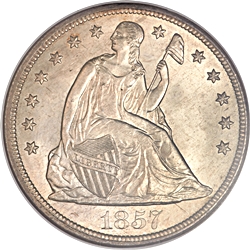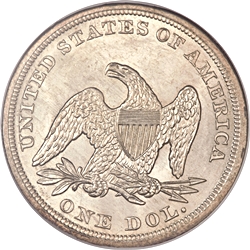 |
1857 
 |
 |
General CommentsThe finest known business strikes are MS66. NGC has graded three coins at this level. The highest graded coin at PCGS is a single MS65+. They have graded two additional coins at the MS65 level. NGC has not graded any at this level. 27 coins have been graded MS64, 6 at PCGS and 21 at NGC. A total of 107 coins have been designated mint state by the two major grading services. Those mint state coins represent almost half of the certified population. The lower circulated grades are a problem for collectors seeking to assemble a low- to mid-grade set. The two services combined have graded only 15 coins less than XF, making this one of the tougher coins in the series at those grade levels. Population statistics are as of January, 2019. |
|
1857 dollars are notorious for their weak strikes, often displaying very poor detail on the hair and star centrals. Reverse strikes are usually better, but can still show some weakness on the upper left-wing feathers. They can be found with strong strikes. An example is the Gardner coin, an NGC MS66, last offered by Heritage in February, 2016 (in a different holder than the one it occupied during the Gardner auction). Such coins are extremely rare. High-grade business strikes are usually frosty, but prooflike examples are encountered more frequently for this date than for others in the era.
1857 Die Marriages
Only 3 die pairs have been identified. Two different business strike die marriages used different obverse and reverse dies. The OC-1 obverse die was first used to strike proof issues. A single proof variety paired that obverse die a reverse used only for proofs. The following table summarizes the known die marriages for 1857:
Die Marriage |
Rarity |
Obverse Die |
Reverse Die |
Estimated Survivors |
| OC-1 | R5+ | P1 | A | 45 |
| OC-2 | R3 | 1 | B | 355 |
| OC-P1 | R5 | P1 | 1856 PA | 50 |
OC-P1 is the only known proof die marriage. Itís a rare proof, with only 50 or so estimated survivors from a mintage that we estimate as 75-90. The finest known is a single PR66+ example slabbed by NGC, the Gardner coin. The obvers die used to strike OC-P1 was later used to strike business strikes, our die pair OC-1. The reverse die is transitional. It was first used to strike proofs in 1856, then 1857, and finally 1858. Breen (reference 7) indicates a second proof die marriage, with a reverse die that was re-used in 1858. Weíve been unable to locate any record of this second proof die marriage, nor have we found any 1858 proofs with reverse dies used in 1857 other than Reverse 1856 PA. Several examples of OC-1 have been erroneously attributed as proofs. Itís possible that Breen was referring to one of these, but that doesnít explain the reverse die attribution. The second die marriage referenced by Dave Bowers (reference 4) is explained by these mis-attributed business strikes. He indicates that the reverse die for his first die marriage was used in both 1854 and 1856. We think the 1854 reference is incorrect.
1857 Business Strike Emission Sequence
With only two business strike die marriages and no shared dies the emission sequence is simply a guess. Weíve assumed that the die marriage which shared the proof obverse die came first.
Emission Order |
Die Marriage |
Comments |
| 1 | OC-1 | |
| 2 | OC-2 |
1857 Proof Emission Sequence
With only a single proof die marriage this sequence isnít terribly interesting.
Emission Order |
Die Marriage |
Comments |
| 1 | OC-P1 |
1857 Quick Finder Chart
With only 2 obverse dies and 3 die marriages 1857 die marriages are relatively easy to identify. The following chart gives the key attribution points for each die marriage.
Die Marriage |
Obv. Die |
Rev. Die |
Right Base |
Keys to Identification |
| OC-1 | P1 | A | LE | Obverse Ė Lumps on the gown just above the leg left of the pole.
Reverse Ė Heavy die lines slant diagonally up to the right in the lower recesses of the shield. The surfaces between the leaves are fully finished. |
| OC-2 | 1 | B | JL of RE | Obverse Ė Two notable die lines in a slightly unfinished area below the toe Reverse Ė Notable die lines slant up from the denticles above NIT. The surfaces between the leaves are mostly unfinished. |
| OC-P1 | P1 | 1856 PA | LE | Obverse Ė Lumps on the gown just above the leg left of the pole.
Reverse - Small die rust lumps on the top of the lower left side of the L in DOL. |
| Photo credits:
Obverse and reverse full photos: 1857 NGC MS66, from the Heritage archives. |
